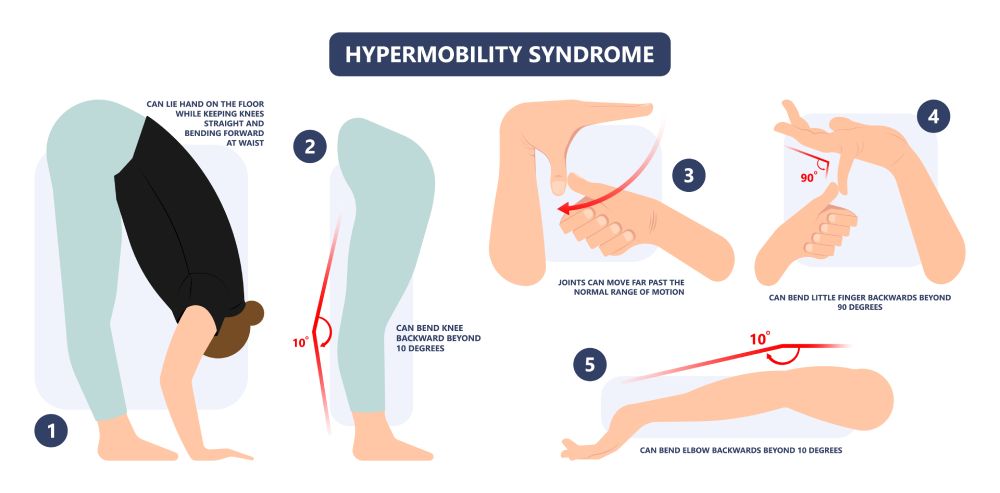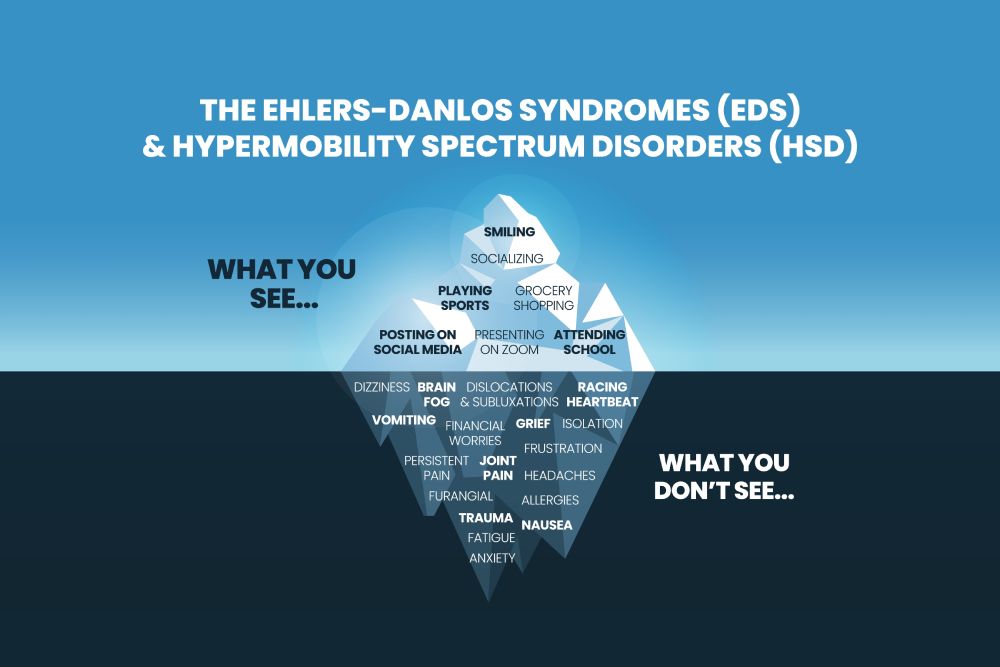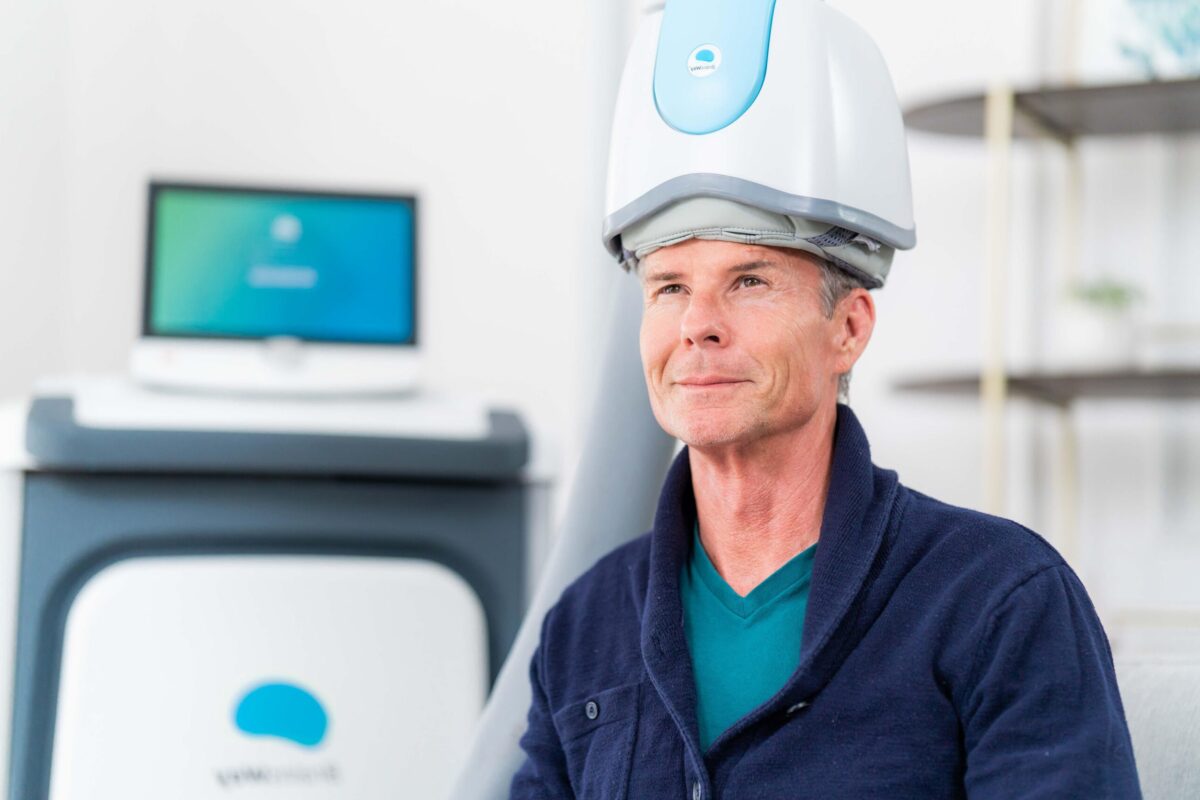Hypermobility, Ehlers-Danlos Syndrome (EDS), and cervical instability are interconnected conditions that can significantly impact neurological health. These conditions are often overlooked in the diagnostic process, yet they can mimic or intensify a range of neurological disorders such as dysautonomia, Lyme disease, and concussions.
Denver Clinic for EDS/ Hypermobility: Patient Education, Advanced Therapies, Curated Plans
Ehlers-Danlos Syndrome (EDS)
What is it? EDS is a group of genetic connective tissue disorders characterized by hyperelastic skin, joint hypermobility, and tissue fragility.
Pathophysiology: EDS involves mutations affecting collagen production or structure, which is essential for strong connective tissues. This leads to:
- Joint Hyperflexibility: Increased range of motion, often causing dislocations, excessive movement causing temporary venous compression or peripheral nerve compression.
- Skin Elasticity: Stretchy, fragile skin that bruises easily.
- Vascular Fragility: Increased likelihood of damage, dynamic occlusion, and poor blood supply to various organs, muscles, your brain, and your gut.
Hypermobility
What is it? Hypermobility refers to joints that move beyond the normal range. It can occur on its own or as part of a syndrome like EDS.
Pathophysiology: Hypermobility is often due to lax ligaments and altered collagen, leading to:
- Joint Instability: Increased risk of injury and chronic pain due to the expansive mobility/ stability gap. Potential for excessive movement causing temporary venous compression or peripheral nerve compression.
- Proprioceptive Challenges: Difficulty sensing joint position, affecting balance and coordination.
Cervical Instability
What is it? Cervical instability involves excessive movement between the vertebrae in the neck.
Pathophysiology: Caused by weakened ligaments or trauma, leading to:
- Neck Pain and Headaches: Due to venous occlusion to the nerve, rather than a compression, leading to neuro-muscular dysfunction or irritation.
- Neurological Symptoms: Such as dizziness, visual disturbances, and autonomic dysfunction, as unstable vertebrae can affect nearby nerves and blood vessels.
Interconnections
These conditions share connective tissue abnormalities, leading to overlapping symptoms and potential complications. Understanding their pathophysiology helps tailor effective treatment strategies, addressing both structural and neurological challenges.

Symptom Constellations
- Joint Pain and Instability: Common in hypermobility and EDS, leading to increased risk of injury.
- Neurological Symptoms: Dizziness, headaches, attention and cognitive difficulties, anxiety, depression and other symptoms can arise, resembling or intensifying conditions like concussions, Lyme, FND, PANS/PANDAS, and others.
- Dysautonomia: Issues with autonomic regulation, causing symptoms like lightheadedness, increased heart rate, dry eyes/mouth, gut dysfunctions, headaches, constipation, and much more.
- Chronic Fatigue: Often experienced due to ongoing inflammation, dysregulation, cellular energy, pain and instability.
- Digestive Problems: EDS and related conditions can lead to gastrointestinal dysregulation, SIBO, and other changes.
Overlooked Connections
Many healthcare providers may not connect these symptoms with hypermobility or EDS, instead attributing them to other conditions. This can lead to misdiagnosis and ineffective treatment plans.
Treatment Approach at Axon Integrative Health
At Axon Integrative Health, we emphasize a comprehensive brain-body-mind approach, recognizing the unique challenges posed by hypermobility, EDS, and cervical instability. Our treatment plans include:
- Basic Lifestyle Guidelines:
- Nutritional support to reduce inflammation and support connective tissue health.
- Stress management techniques, including mindfulness and relaxation exercises.
- Sleep hygiene practices to improve circadian rhythm and restorative sleep cycles
- Strengthening Programs:
- Customized exercises to enhance muscle tone, dynamic joint stability, and motor control.
- Neuromuscular Reeducation:
- Techniques to improve coordination and proprioception. A better brain body connection will allow for a more structurally sound system.
- Chiropractic and Physical Medicine:
- Corrective Exercise, Functional Movements, and Manual Therapies along with Physical Medicine treatments to support spinal stability, mobility, and motor control through brain body connections.
- Advanced Therapies:
- PEMF (Pulsed Electromagnetic Field Therapy): Enhances cellular repair and reduces pain through Ca+gated ion channels- healing magnetic frequencies you can feel.
- Laser Therapy: Promotes healing, cellular energy production, and reduces inflammation through upregulation of the mitochondria.
- Dry Needling: Improves muscle control and pain by activating a complex brain body circuit to modulate muscle tension and perception.
- Ozone Injections and Stem Cells: Innovative treatments to support tissue regeneration and repair.
- Supplementation:
- Collagen: Enhances cellular tissue health and repair also reduces pain.
- Creatine: Greatly improves cellular energy and improves inflammation response.
- Immunoglobulins: Helps mount proper immune responses, modulates gut brain axis.
- Vitamin C: Improves cellular turnover and regulation of new cells.
- Peptides: Peptides like BPC157 and TB500 can help accelerate tissue healing and tendon/ligament repair.
Axon is a Denver based clinic that helps patients from around the world with complex neurological problems including EDS, Hypermobility, and Cervical Instability. Our personalized treatment plans are designed to address the root causes of symptoms, offering a holistic path to improved health and well-being. By integrating various cutting-edge, evidence-based therapies tailed to your Brain-Body-Mind, we aim to empower patients on their journey to recovery and enhanced quality of life.





